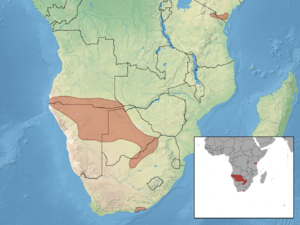Acontias percivali facts for kids
Quick facts for kids Acontias percivali |
|
|---|---|
 |
|
| Conservation status | |
| Scientific classification | |
| Genus: |
Acontias
|
| Species: |
percivali
|
 |
|
Acontias percivali, also known as the Percival's lance skink or Tanzanian legless lizard, is a small lizard that looks a lot like a snake! It doesn't have any legs. This unique lizard belongs to the Scincidae family, which includes many types of skinks. You can only find this species in Africa.
Contents
What's in a Name?
The name percivali was given to honor a British naturalist named Arthur Blayney Percival. He was a game warden in East Africa from 1874 to 1940.
Where Does it Live?
Percival's lance skink lives only in certain parts of Africa. You can find it in countries like Angola, Botswana, Kenya, Namibia, South Africa, Tanzania, and Zimbabwe.
What is its Home Like?
This special skink lives in savannas. It likes to burrow just below the surface of the soil. This helps it stay hidden and find food.
Different Types of Percival's Lance Skink
Scientists have found two main types, or subspecies, of A. percivali:
- A. p. percivali (named by Arthur Loveridge in 1935)
- A. p. tasmani (named by Hewitt in 1938)
Some recent DNA tests suggest that A. p. tasmani might actually be a subspecies of a different skink, Acontias meleagris. Scientists are still studying this!
What Does it Look Like and Eat?
Percival's lance skink has a copper-brown back and a shiny gold underside. It is an insectivore, meaning it eats insects. It especially likes to munch on beetle larvae, earthworms, and other slow-moving creatures without backbones.
How Does it Have Babies?
A. percivali is ovoviviparous. This means the mother carries her eggs inside her body until they hatch. Then, she gives birth to live young. A mother skink usually has one to five babies at a time.
Can You Keep Them as Pets?
Even though we don't know a lot about A. percivali, you might sometimes see them in pet shops. Most of these skinks are caught in the wild. If you keep them as pets, they need a deep layer of sand to burrow in. They also need places to hide on the surface. It might be possible to breed them in captivity, but it hasn't been done much for commercial pet sales yet.


